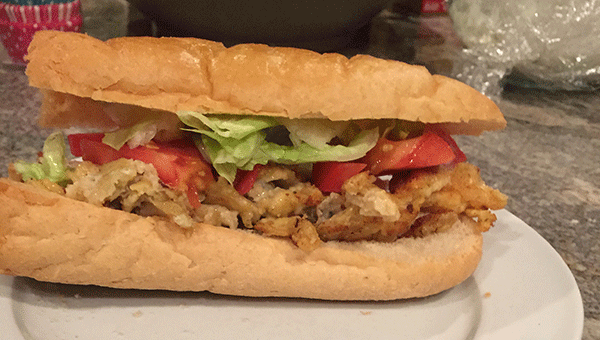Nothing ‘Po’ about this sandwich
Published 1:18 am Saturday, October 10, 2015
Po ‘Boys have inspired a variety of stories as to their origin. In New Orleans, they first became well known during the street car drivers strike in the late 1920s, when Martin Brothers Restaurant (owned by retired drivers) began giving the hungry strikers sandwiches made of whatever could be easily put in a split loaf of French bread. Some were loaves filled with fried potatoes and beef gravy. There have been many restaurants since then, that have offered a variety of Po ‘Boys as their entire menu. The bakeries in the city make a French loaf that is wide at both ends, just for making Po ‘Boys.
The most popular Po ‘Boys are the roast beef (served dripping with “debris gravy”) and the oyster Po ‘Boy (filled with hot fried oysters), but there are also catfish, shrimp or soft-shell crab Po ‘Boys. Even at the local chains of little convenience stores call “Time Savers,” the clerks make fresh hot Po ‘Boys to order, just like at the New Orleans dime store lunch counters, cafes, and sandwich shops did during most of the 20th Century.
Tradition has it also that during the 19th century, oyster Po ‘Boys were known as the “Peacemakers,” since they were often brought home to angry wives as peace offerings by men who had stayed our too late at night in the saloons.
We have tasted many good Po ‘Boys in New Orleans but I thought it was time to do my own at home and see how mine rated. Oyster season is back and I picked up a pint yesterday at Tony’s seafood in Baton Rouge. This is the recipe I used and tonight is oyster Po ‘Boy night!
Oyster Po ‘Boy
Serves 2
16-20 fresh oysters
1 cup flour or corn flour
1 cup dry French bread crumbs
½ cup evaporated milk
2 eggs
¼ tsp. salt
¼ tsp. pepper
¼ tsp. cayenne
1 French bread loaf (16”-20”long)
Butter
Oil for frying
Mayonnaise or tartar sauce
Crisp shredded lettuce
Thin tomato slices
Dill pickle chips
Pat the oysters dry with a clean cloth and season them with the pepper and cayenne. Beat the eggs well and blend in the milk and salt. Gently roll each oyster in the flour and then dip it into the egg mixture. Roll it in the bread crumbs, coating it well, then shaking off the excess. Set the oysters on a plate, and when all are ready to cook, put the plate in the refrigerator to chill.
Preheat the oven to 350°. Slice the French bread in half and then horizontally. Pull out much of the bread with a slotted spoon, leaving 4 boat-shaped crusts. Butter the inside lightly and place them on a cookie sheet in the oven to lightly heat.
Heat the frying oil to 375° and put about 6 of the oysters at a time in the oil, turning them to cook evenly. When golden, remove them with a slotted spoon to paper to drain. Do not pierce with a fork.
Spread the four inside surfaces of the hot bread with mayonnaise or the Creole sauce (given below). Po ‘Boys are often ordered “dressed” which means with shredded lettuce, tomato slices and sometimes dill pickles, all arranged on the bottom layer. Then the hot oysters are laid in. Some cooks sprinkle the oysters with Tabasco before closing the sandwich. They are best enjoyed hot, as soon as they are assembled.
Creole Tartar Sauce
Makes 1 cup
1 cup mayonnaise
1 Tbsp. Creole mustard
¼ tsp. cayenne
1 tsp. salt
¼ cup very finely chopped green onion
¼ cup finely chopped parsley
¼ cup finely chopped pickles
Blend the ingredients together evenly and spread on the Po ‘Boy loaves with the fried oysters. The sauce goes well with boiled crabs, shrimp or crawfish—all types of fried seafood.
This Po ‘Boy sandwich was delicious. My husband said it was one of the best he had had, but a bit messy! Not such a big price to pay for good food.






